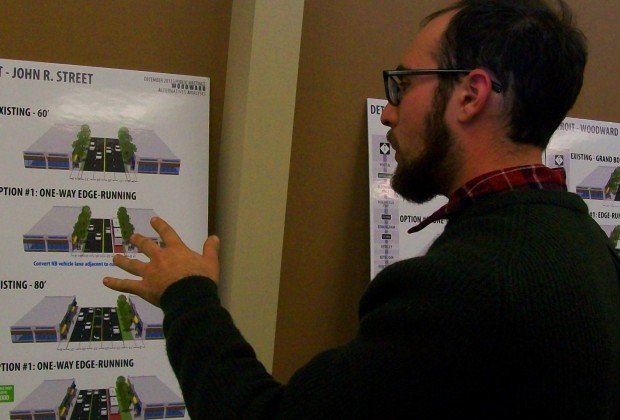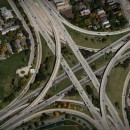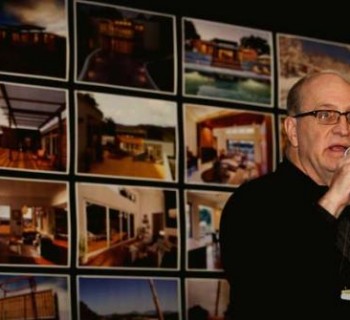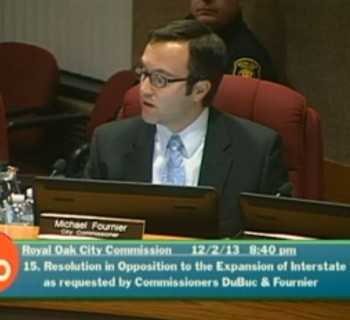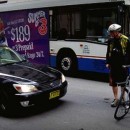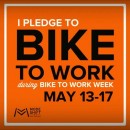Jason Lindy checks out BRT informational charts at SEMCOG's Dec 11 public meeting in Detroit.
DETROIT—An effort to bring a high-speed bus line to the Woodward corridor shuttled through another critical juncture this past week. The Southeast Michigan Council of Governments and their consultant, Parsons Brinckerhoff, have wrapped up their third round of public meetings needed to collect citizen input and move the project forward.
Bus Rapid Transit is a modern form of transit that's already in place in a number of cities like Cleveland, Las Vegas and Grand Rapids. It relies on a fleet of special buses equipped with traffic light-altering sensors and other features that shorten ride times.
SEMCOG is working in tandem with southeast Michigan's Regional Transit Authority to bring high-speed buses to the region. The proposed Woodward route, which would span 11 communities from downtown Detroit to Pontiac, is one of four corridors being considered for a regional rapid transit network; the others would be located along Gratiot, Michigan and Grand River Avenues.
In October during a visit to Detroit, U.S. Transportation Secretary Anthony Foxx awarded the RTA $6.4 million to help implement the BRT network. In addition to federal funding, the RTA is considering putting a millage before voters to cover remaining capital costs as well as operational costs associated with the network.
"There's no continuous transit option now available along the corridor," PB spokeswoman Sharmila Mukherjee said during a Dec. 10 presentation at Next Energy in Detroit's TechTown district. "This BRT project would significantly enhance current public transit. It's going to complement what already exists -- both M-1 Streetcar, that's going to be built, and the current bus service."
The BRT research is part of a multi-year study SEMCOG has been conducting called the Woodward Avenue Rapid Transit Alternatives Analysis. It's been examining whether light rail or one of two types of BRT, fixed-guideway or mixed-in-traffic, would be the best way to bring high-speed mass transit to Woodward.
Fixed guideway means that the buses would have their own special designated lanes, while mixed-in-traffic, as the name suggests, would mean buses would share a lane with other motorists.
Since the study began, light rail has been dropped from consideration in favor of the two BRT options. The December public meetings focused on presenting information and gathering feedback on the setup and path of a potential Woodward BRT route.
A baseline route running straight up Woodward is being considered along with several alternatives branching off of Woodward in certain locations. These include two downtown Pontiac options, one for downtown Berkley, two for Royal Oak, four for Detroit south of Grand Boulevard and an additional four for downtown Detroit. (View the route map and station sites).

Three cross-sections for the bus routes are also up for review: one running through the median or center of the road, one running on the edge of the median, and another running along the side of the street or sidewalk. (Visual representation and comparisonof cross-sections).
Presenters at the Dec. 11 meeting stressed that because Woodward varies so much in its layout, a combination of different cross-sections could potentially be used for different spans of the route. They added that the plan is being coordinated with other Woodward projects like M-1 Rail and the corridor's Complete Streets planning effort.
Ridership for the proposed Woodward BRT route is projected around 35,000 people a day. The combined daily ridership for DDOT and SMART along the corridor is currently about 18-20,000.
Potential riders living south of Eight Mile Road would be more likely to ride out of necessity, while those living north of the road would be more likely to ride out of choice, according to PB spokeswoman Sarah Binkowski. For this reason, SEMCOG is interested in keeping travel times competitive with automobiles to attract more optional riders.
Audience members at the Next Energy meeting were generally supportive of BRT, but had differing opinions as to specifics.
Elizabeth Luther, a Citizen's Advisory Committee member with the RTA, told Mode Shift she didn't have any definitive opinion on the routes, but still had some thoughts to share.
"Center running, based on what I know, seems a bit safer option," she said. "Probably not running a BRT through a downtown loop is a wise choice."
Jason Lindy, 23, of Detroit, couldn't understand why the project focused solely on the Woodward Corridor. "I really wish that I'd seen more than just one complete axle," he said. "It seems to me, when you're developing BRT, the point is you can keep building stops. And so to show one completed line as opposed to multiple lines that can continue onward ... I don't see this as something that when [a millage] comes to be voted on will be that appealing to folks that live in the area."
Nathan Harvey, a 54-year-old architect from Highland Park, seemed to be a fan of light rail, but told Mode Shift he understands BRT is more cost effective.
"If we can get dedicated lanes and make it happen with buses, I don't have a problem with it," he said. "I recognize that Woodward changes a lot in those 27 miles and we'll probably have a bunch of options along the way, which is fine. I'm trying to get used to the Cass and John R. option to make room for the light rail, other than that I'm satisfied with it."

While the study's public meetings component is completed now, stakeholder meetings will continue to be held as needed while the project is refined. From there a preferred option will need to be selected; that's expected to happen in March 2014.
The plan will also need to undergo a federal environmental review and receive formal approval from both SEMCOG and the RTA.


